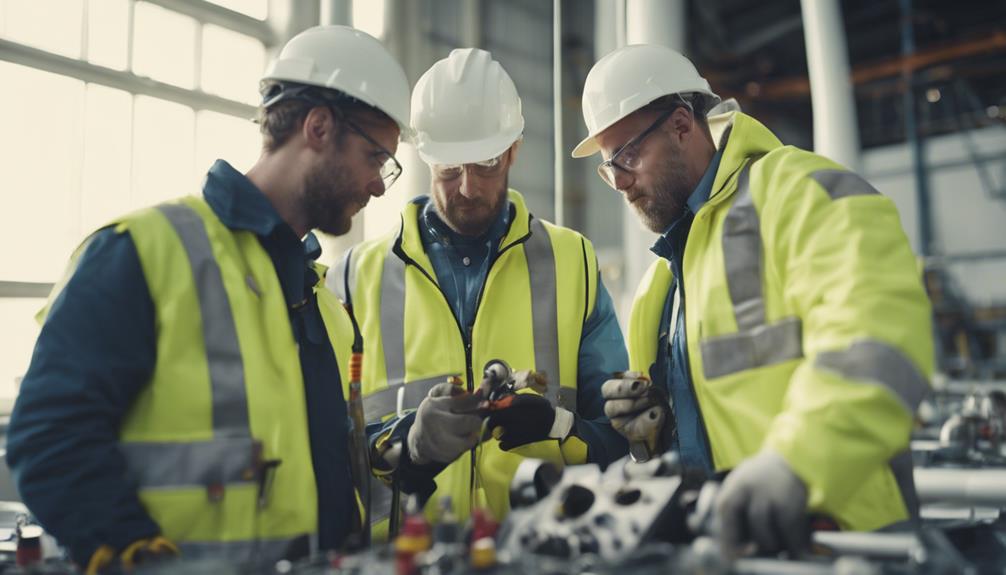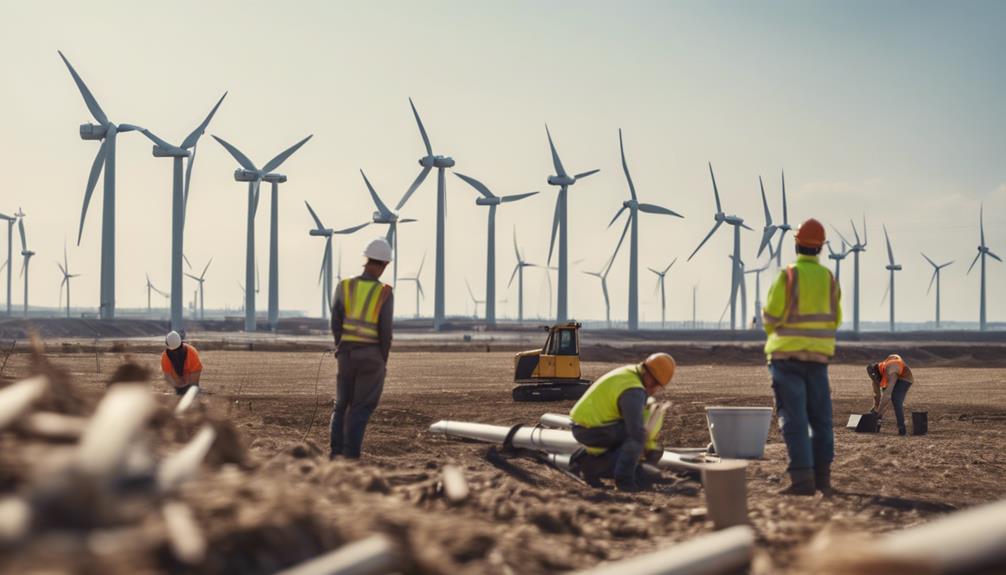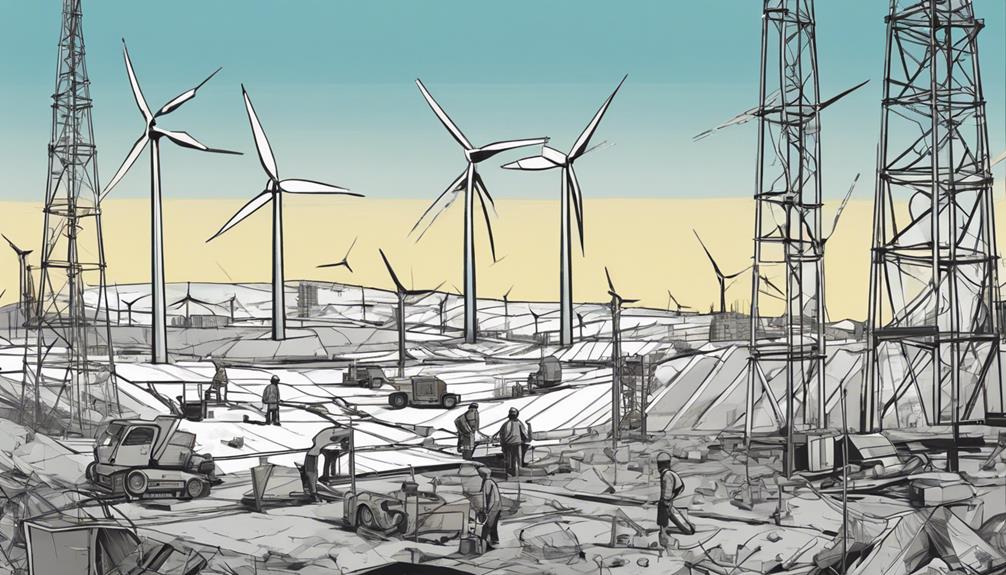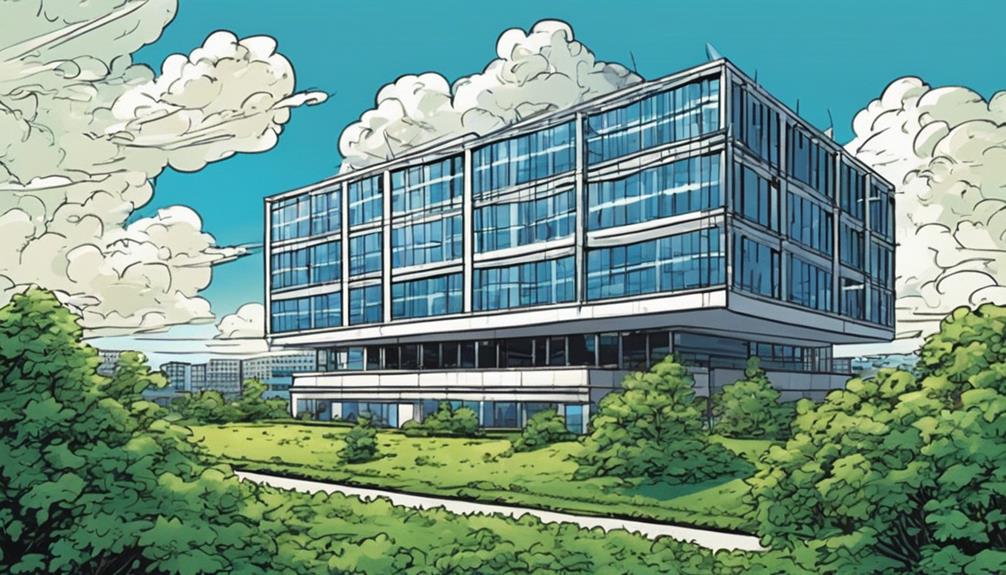To build a wind turbine power plant, it can cost you between $2.5 to $4 million per turbine. The total investment varies based on factors like location, size, and specific project needs. If you want to uncover more insights about wind turbine costs and profitability, dig deeper into the details provided.
Key Takeaways
- Costs range from $2.5 to $4 million per turbine.
- Manufacturing contributes 70% to the total cost.
- Site preparation and grid connection add to expenses.
- Offshore projects can exceed $100 million.
- Total costs vary based on size, location, and project needs.
Wind Turbine Cost Breakdown
Breaking down the cost of building a wind turbine power plant reveals the key expenses involved in this renewable energy infrastructure. Commercial wind turbines typically range from $2.5 to $4 million to construct, with manufacturing accounting for 70% of the total cost.
Site preparation, land acquisition, and grid connection also contribute to the overall expenses. In the case of offshore wind turbines, the costs can escalate significantly, exceeding $100 million due to the complexities of construction at sea.
The total cost of constructing a wind turbine power plant varies depending on factors such as size, location, and specific project requirements. Understanding the cost breakdown is vital in planning and budgeting for the development of wind energy projects.
Wind Energy Profitability Analysis

Analyzing the profitability of wind energy involves evaluating various factors like location, wind speed, grid connection, and maintenance costs to determine the financial viability of wind power projects.
The costs associated with wind turbines, including installation and ongoing maintenance, directly impact the overall profitability of wind energy ventures.
The capacity factor of wind turbines, which represents the amount of energy produced compared to its maximum potential, plays a pivotal role in determining profitability. Higher capacity factors allow for more electricity to be sold back to the grid, aiding in recouping initial investment costs.
Additionally, government incentives, subsidies, and evolving Power Purchase Agreements (PPAs) can influence the financial returns of wind energy projects.
Wind Turbine Maintenance Expenses

Wind turbine maintenance expenses can have a significant impact on the overall operational costs of wind power plants. Annual maintenance costs typically range from $42,000 to $48,000. These expenses, which can increase as turbines age, usually amount to 1-2 cents per kilowatt-hour produced.
O&M costs encompass various elements such as insurance, repairs, administrative tasks, and power costs. Lightning protection is vital for wind farms to prevent damage from strikes; products like StrikeTape offer durable lightning diverters for turbines.
Turbine Performance Factors

As wind turbine maintenance expenses can greatly impact operational costs, understanding turbine performance factors is vital to optimizing electricity production and profitability.
Factors such as wind speed, direction, and variability play an integral role in determining the capacity factor of both onshore and offshore wind turbines. Onshore turbines typically operate at 30-40% capacity, while offshore turbines can achieve up to 65% capacity, influencing their electricity production levels over time.
The capacity factor essentially indicates how much electricity a wind turbine generates compared to its maximum potential output. While turbines can reach full capacity at peak wind speeds, the overall capacity factor is affected by wind variability.
Maximizing capacity factors is crucial for wind turbines to increase their electricity production and ultimately boost profitability. By considering these performance factors, wind turbine operators can enhance their operational efficiency and financial returns.
Technical Details of Wind Turbines

The GE Haliade-X 12 MW turbine stands as the largest available wind turbine in the industry today. Commercial wind turbines typically range from 200 to 260 feet in height, with blade tip speeds ranging from 120 to 180 mph.
Offshore turbines can reach capacities of up to 18 MW, featuring larger blades and taller towers. Turbine designs have shifted towards larger sizes, simplifying power transport and reducing complexities in wind farm construction.
While wind turbine costs tend to increase with size, the trend towards fewer, larger turbines offers benefits regarding efficiency and maintenance. These advancements in turbine size and design not only enhance energy production but also contribute to the overall sustainability of wind energy projects.
Understanding the technical details of wind turbines, such as blade length, efficiency, and maintenance requirements, is essential for optimizing the performance and longevity of wind power systems. By staying informed about the latest developments in turbine technology, you can make more informed decisions when investing in renewable energy infrastructure.
Energy Sources and Production

Renewable energy sources play a pivotal role in diversifying power generation and reducing carbon emissions. When it comes to wind power, commercial wind turbines carry substantial costs, averaging between $2.5 to $4 million each. The cost to build a wind turbine power plant typically amounts to around $1.3 million per megawatt of capacity.
Wind turbine manufacturing expenses can vary, influenced by market dynamics affecting major producers like Siemens and Nordex. Despite the significant initial investment required for wind turbines, they contribute steadily to the system by generating electricity. Implementing larger turbines can simplify wind farm construction, with offshore turbines boasting capacities of 16-18 MW.
- Commercial wind turbines cost millions of dollars each, with an average price ranging from $2.5 to $4 million per turbine.
- Typical cost for building a wind turbine power plant is around $1.3 million per megawatt of capacity.
- Wind turbine manufacturing costs can vary, with major manufacturers like Siemens and Nordex experiencing fluctuations.
- Initial investment in wind turbines is significant, but they contribute to the power grid with their electricity production over time.
- Larger turbines can reduce complexity in wind farm construction, with offshore turbines reaching capacities of 16-18 MW.
Electricity Sector Insights

When considering the costs of building a wind turbine power plant, it's important to understand the various factors that contribute to the overall expenses. Factors such as turbine size, location, and project-specific conditions play a significant role in determining the total investment required.
Cost Factors
Considering the substantial impact on costs within the electricity sector, understanding the various factors influencing the expense of building a wind turbine power plant is important.
When evaluating the total cost factors of constructing a wind turbine power plant, several key elements play a major role:
- Manufacturing Costs: Manufacturing constitutes a significant portion, approximately 70%, of the total turbine cost.
- Site Preparation: Proper site preparation is vital for the installation process and adds to the overall expenses.
- Land Acquisition: Acquiring suitable land for wind turbine placement can contribute significantly to the project cost.
- Grid Connection: Ensuring a reliable connection to the grid is important and involves additional expenses.
- Turbine Size, Location, and Project Conditions: The total cost varies based on the size of the turbine, its location (onshore/offshore), and specific project conditions.
These factors collectively determine the financial outlay required for establishing both onshore and offshore wind turbine power plants.
Investment Considerations
Understanding the financial aspects of investment considerations in the electricity sector provides valuable insights for building wind turbine power plants. When evaluating the total investment required for constructing a wind turbine power plant, factors such as manufacturing components, site preparation, land acquisition, and grid connection play pivotal roles.
The cost of manufacturing components alone can make up a significant portion, approximately 70%, of the total investment in larger turbines. Additionally, the installation complexities associated with larger turbines, especially offshore ones, can escalate costs substantially. Turbine size, location, and specific project conditions also influence the total investment needed to establish a wind turbine power plant.
While onshore projects generally range between $2.5 to $4 million per turbine, offshore installations can surpass $100 million due to the increased scale and complexities involved. Considering these investment considerations is essential for accurately budgeting and planning the development of a wind turbine power plant.
Energy Consumption Trends

Energy consumption trends indicate a noticeable shift towards renewable sources like wind power. This movement is driven by various factors, including the environmental benefits and decreasing costs associated with wind energy.
Here are some key points related to the energy consumption trends and the construction costs of wind turbine power plants:
- Wind power is gaining popularity as a renewable energy source.
- The size and location of wind turbines impact construction costs.
- Building a wind turbine power plant can cost anywhere from millions to over a hundred million dollars.
- Site preparation, land acquisition, and grid connection are significant contributors to overall expenses.
- Commercial wind turbines typically range from $2.5 to $4 million, with offshore turbines costing over $100 million.
As more emphasis is placed on sustainable energy solutions, wind power continues to play an essential role in meeting energy demands while reducing carbon emissions.
Gasoline Prices Update

Gasoline prices continue to be influenced by various factors, including crude oil prices and distribution costs.
The average U.S. gasoline price in 2023 stood at $3.24 per gallon, with fluctuations tied to geopolitical events and supply disruptions.
Consumers are impacted by changes in gasoline inventories, monitored weekly by the Energy Information Administration.
Current Gasoline Prices
The latest update on gasoline prices reveals a steady increase in the cost per gallon across various regions. When considering the cost of building a wind turbine power plant, it's vital to acknowledge the current gasoline prices as they impact overall construction expenses:
- Gasoline prices directly affect transportation costs for materials and equipment.
- Higher gasoline prices may lead to increased construction costs due to elevated transportation expenses.
- Fluctuations in gasoline prices can influence the budget allocated for site preparation and land acquisition.
- Grid connection costs may rise if gasoline prices continue to climb, affecting the total turbine cost.
- The size and location of the project play a significant role in determining how gasoline price changes impact construction costs.
Understanding the correlation between current gasoline prices and wind turbine power plant construction expenses is necessary for accurately estimating project costs.
Gasoline Inventory Trends
Ongoing fluctuations in gasoline inventory levels provide valuable insights into current market dynamics affecting fuel prices. Gasoline inventory trends are pivotal indicators influenced by factors such as supply chain disruptions and geopolitical tensions. Monitoring these levels is essential for understanding how changes in supply and demand can impact gasoline prices, directly affecting retail prices for consumers.
Seasonal variations also play a significant role in gasoline inventory levels, reflecting shifts in market movements and consumer behavior.
Government data on gasoline inventories is publicly accessible and widely used for analysis and forecasting purposes. By examining these trends, analysts can better predict future price movements and anticipate potential changes in the market.
Understanding the relationship between gasoline inventory levels and gasoline prices is key to making informed decisions in the energy sector and staying ahead of market fluctuations driven by various external factors.
Industrial Wind Turbine Costs

Industrial wind turbine costs can vary greatly depending on the type and size of the turbine being contemplated. Here are some key points to keep in mind:
- Onshore industrial wind turbines typically generate 2 to 3 MW, while offshore turbines can reach capacities of up to 12 MW.
- Costs for industrial wind turbines can range from $1 million per MW for onshore turbines to tens of millions for large offshore turbines.
- The manufacturing process accounts for about 70% of the total turbine cost.
- Government grants and tax breaks incentivize investment in utility-scale wind power projects.
- New materials and manufacturing techniques aim to reduce costs and enhance turbine durability.
When evaluating industrial wind turbine costs, factors such as turbine size, location, and available incentives play a significant role. With advancements in technology and a focus on cost reduction, the cost of wind energy continues to decrease, making wind power an increasingly attractive option for meeting energy needs in the United States.
Frequently Asked Questions
How Long Does It Take for a Wind Turbine to Pay for Itself?
To pay for itself, a wind turbine typically takes 12 to 20 years. Factors like initial costs, maintenance, and electricity sales influence this period. Offshore turbines may need longer due to higher expenses.
How Much Money Does a Wind Turbine Make per Year?
Each wind turbine can earn $300,000 to $500,000 annually. Factors like wind speed and maintenance influence this income. High capacity factors maximize production. Profitability depends on location, maintenance costs, and electricity prices.
How Much Does a 500KW Wind Turbine Cost?
When building a 500kW wind turbine, costs typically range from $1-$2 million. Factors like size, location, and project needs influence prices. Yearly maintenance costs can be around $10,000-$25,000. Recovery through electricity generation usually takes several years.
How Much Does It Cost to Build and Install One Wind Turbine?
To build and install one wind turbine, it can cost anywhere from $2.5 to $4 million for a commercial turbine. Offshore turbines may exceed $100 million. Manufacturing makes up 70% of the total cost.
Can Oil Consumption Impact the Cost of Building a Wind Turbine Power Plant?
The oil required for wind turbine during the construction phase can impact the overall cost of building a wind turbine power plant. Higher oil consumption can lead to increased expenses, affecting the project budget and potentially delaying the completion of the power plant. Careful management of oil usage is crucial for cost control.
Conclusion
So, now you know how much it costs to build a wind turbine power plant. Remember, the upfront investment may seem high, but the long-term savings and profitability make it a wise choice.
Just look at the case study of Company X, which saw a 30% decrease in energy costs after installing a wind turbine power plant.
Don't let the initial cost deter you from reaping the benefits of clean, sustainable energy!










